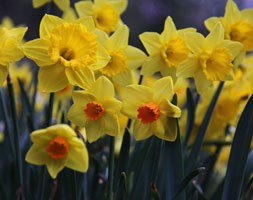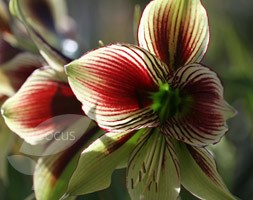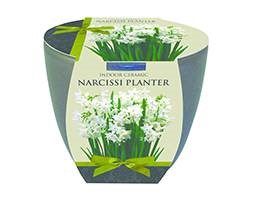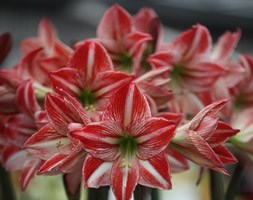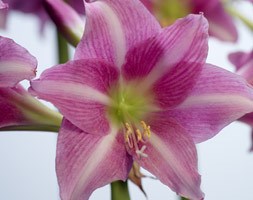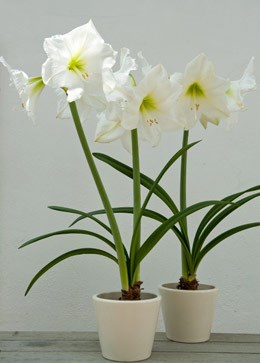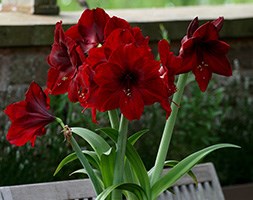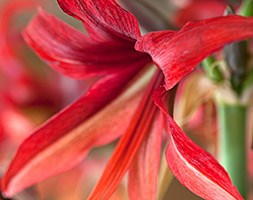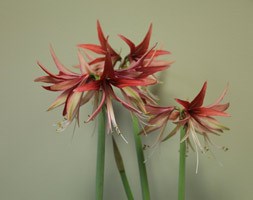New products at Crocus
by Sarah - March 13th, 2014.Filed under: Crocus, New Products.
New products today at Crocus
mixed Narcissus for naturalising (mixed daffodil collection bulbs) £44.99
This bag is sold by weight but may contain approx 350 bulbs (this is a guide only as it is dependant on the bulb size ) Position: full sun or partial shade Soil: well-drained soil Rate of growth: average to fast-growing Flowering period: March and April Flower colour: shades of golden-yellow and pure white Other features: strap-shaped, dark green leaves; excellent as cut-flowers; contact with the sap may cause skin irritation Hardiness: fully hardy Bulb Size: 12/14 Splendid, single and bi-coloured flowers in shades of golden-yellow and pure white in March and April. This collection of top-quality daffodils and narcissi is ideal for naturalising in a sunny, well-drained border or lawn. To guarantee a colourful display and a supply of excellent cut-flowers plant 10-15cm (4-6in) deep in late summer or early autumn. Garden care: Plant 10-15cm (4-6in) deep from late summer to early autumn. After flowering feed with a balanced fertiliser, dead-head and allow the leaves to die back naturally.
Hippeastrum papilio (butterfly amaryllis bulb) £9.99
Position: bright but not in full sun Soil: good quality potting compost Flowering period: September to December Flower colour: red and white Other features: knock-out flowers Hardiness: frost tender Bulb Size: 26/28 Unlike ordinary amaryllis, ‘Papillo’ has several flower stems which are shorter than most amaryllis and these are covered in elegant red and white trumpets. It flowers 6 weeks after planting and looks wonderful planted 3 to a pot. It will also come back year after year – fabulous! General care: Fill a pot with good quality potting compost, setting the bulb in the compost so that the top two thirds are exposed. Water the compost only when the surface is dry, watering too much just after potting can cause the bulb to rot. Keep the plant in a sunny spot, though not direct sun and rotate the plant so as to avoid the flower stalk leaning towards the light. Once flowering has finished cut off the flower stalk 5-10cm above the bulb – don’t cut off the foliage. Water when the surface of the compost is dry and feed regularly with a balanced liquid fertiliser. Usually the best thing to do is keep watering it through the summer and in autumn stop watering and move to a dark, dim spot. This simulates the drought season of the plant’s native South America. Allow it to dry out for a few months so that the foliage wilts and dies back. In November bring it back in to the light and start watering again. Old foliage should be removed though take care not to cut any new shoots off. In a few weeks a new flower shoot will appear and flower just in time for Christmas.
Ceramic pot and paperwhite gift set (Ceramic pot and paperwhite gift set) £9.99
Gift set includes ceramic pot, growing media, 3 x bulbs and growing instructions. Position: full sun or partial shade Soil: well-drained soil Rate of growth: fast-growing Flowering period: March and April, as early as December if forced Flower colour: white Other features: excellent cut-flowers Hardiness: frost hardy (may need winter protection) This traditional paperwhite is said to have the strongest scent of all. It can be planted out in the garden, but it is more often planted up into bulb bowls and ‘forced’ to grow early as an indoor plant. The scent is unforgettable and will fill your house for weeks on end. Paperwhite care: Empty two thirds of the supplied growing media into the pot. Place the bulbs with their growing tips upwards and cover with the remaining compost. Ideally the growing tips should be protruding just above the top of the compost. Watersparingly so the compost is moist, but be catreful not to overwater. Place the pot in a light position where temperatures remain around 18-20C. When in flower, move to a cool, bright position to help prolong the flowering period. Rotate the pot occasionally as they will grow towards the light. Keep compost moint but not waterlogged at all times. After the flowers have faded the bulbs can be planted outside in the garden.
Hippeastrum ‘Fairytale’ (belladona lily) £9.99
Position: full sun Soil: moderately fertile, well-drained soil or in loam-based compost, such as John Innes no2, with additional leaf mould and sharp sand Rate of growth: average Flowering period: September to November Flower colour: pink Other features: showy, scented flowers Hardiness: frost hardy A stunning amaryllis with deep velvety, dark maroon flowers with darker centres. An easy-to-grow indoor plant that will produce at least two stems of large flowers and will come back year after year. It also makes a wonderful gift too. Bulb Size: 26/28 General care: Fill a pot with good quality potting compost, setting the bulb in the compost so that the top two thirds are exposed. Water the compost only when the surface is dry, watering too much just after potting can cause the bulb to rot. Keep the plant in a sunny spot, though not direct sun and rotate the plant so as to avoid the flower stalk leaning towards the light. Once flowering has finished cut off the flower stalk 5-10cm above the bulb – don’t cut off the foliage. Water when the surface of the compost is dry and feed regularly with a balanced liquid fertiliser. Usually the best thing to do is keep watering it through the summer and in autumn stop watering and move to a dark, dim spot. This stimulates the drought season of the plant’s native South America. Allow it to dry out for a few months so that the foliage wilts and dies back. In November bring it back in to the light and start watering again. Old foliage should be removed though take care not to cut any new shoots off. In a few weeks a new flower shoot will appear and flower just in time for Christmas. Please note that due to the limited availability of these bulbs we need to take full payment when you place your order so as to reserve stock for you. The bulbs will then be despatched to you during November
Hippeastrum ‘Estella’ (amaryllis bulb) £8.99
Position: bright but not in full sun Soil: moderately fertile, well-drained soil or in loam-based compost, such as John Innes no2, with additional leaf mould and sharp sand Rate of growth: average Flowering period: September to November Flower colour: pink Hardiness: frost hardy Bulb Size: 26/28 Providing interest for the home or conservatory in winter, the large pink flowers, which have distinctive, creamy white midribs, create a vibrant shot of colour during the darkest months of the year. General care: Fill a pot with good quality potting compost, setting the bulb in the compost so that the top two thirds are exposed. Water the compost only when the surface is dry, watering too much just after potting can cause the bulb to rot. Keep the plant in a sunny spot, though not direct sun and rotate the plant so as to avoid the flower stalk leaning towards the light. Once flowering has finished cut off the flower stalk 5-10cm above the bulb – don’t cut off the foliage. Water when the surface of the compost is dry and feed regularly with a balanced liquid fertiliser. Usually the best thing to do is keep watering it through the summer and in autumn stop watering and move to a dark, dim spot. This stimulates the drought season of the plant’s native South America. Allow it to dry out for a few months so that the foliage wilts and dies back. In November bring it back in to the light and start watering again. Old foliage should be removed though take care not to cut any new shoots off. In a few weeks a new flower shoot will appear and flower just in time for Christmas.
Hippeastrum ‘Snow Queen’ (amaryllis Snow Queen bulb) £8.99
Position: bright but not in full sun Soil: good quality potting compost Flowering period: December to March Flower colour: white Other features: knock-out flowers Hardiness: frost tender Bulb size: 26/28 Often in flower at Christmas if planted early enough, this magnificent white flowering amaryllis will often produce several large, trumpet-shaped blooms on top of the tall stems during the coldest months of the year. Wonderful for adding colour and brightness to your home, the flowers will usually open over a period of several weeks. Bulb Size: 26/28 General care: Fill a pot with good quality potting compost, setting the bulb in the compost so that the top two thirds are exposed. Water the compost only when the surface is dry, watering too much just after potting can cause the bulb to rot. Keep the plant in a sunny spot, though not direct sun and rotate the plant so as to avoid the flower stalk leaning towards the light. Once flowering has finished cut off the flower stalk 5-10cm above the bulb – don’t cut off the foliage. Water when the surface of the compost is dry and feed regularly with a balanced liquid fertiliser. Usually the best thing to do is keep watering it through the summer and in autumn stop watering and move to a dark, dim spot. This stimulates the drought season of the plant’s native South America. Allow it to dry out for a few months so that the foliage wilts and dies back. In November bring it back in to the light and start watering again. Old foliage should be removed though take care not to cut any new shoots off. In a few weeks a new flower shoot will appear and flower just in time for Christmas.
Hippeastrum ‘Black Pearl’ (amaryllis Black Pearl bulb) £8.99
Position: bright but not in full sun Soil: good quality potting compost Flowering period: September to December Flower colour: dark maroon Other features: knock-out flowers Hardiness: frost tender Bulb Size: 26/28 A stunning amaryllis with deep velvety, dark maroon flowers with darker centres. An easy-to-grow indoor plant that will produce at least two stems of large flowers and will come back year after year. It also makes a wonderful gift too. General care: Fill a pot with good quality potting compost, setting the bulb in the compost so that the top two thirds are exposed. Water the compost only when the surface is dry, watering too much just after potting can cause the bulb to rot. Keep the plant in a sunny spot, though not direct sun and rotate the plant so as to avoid the flower stalk leaning towards the light. Once flowering has finished cut off the flower stalk 5-10cm above the bulb – don’t cut off the foliage. Water when the surface of the compost is dry and feed regularly with a balanced liquid fertiliser. Usually the best thing to do is keep watering it through the summer and in autumn stop watering and move to a dark, dim spot. This stimulates the drought season of the plant’s native South America. Allow it to dry out for a few months so that the foliage wilts and dies back. In November bring it back in to the light and start watering again. Old foliage should be removed though take care not to cut any new shoots off. In a few weeks a new flower shoot will appear and flower just in time for Christmas.
Hippeastrum ‘Bogota’ (amaryllis bulb) £8.99
Position: bright but not in full sun Soil: moderately fertile, well-drained soil or in loam-based compost, such as John Innes no2, with additional leaf mould and sharp sand Rate of growth: average Flowering period: September to November Flower colour: red Hardiness: frost hardy Bulb Size: 26/28 Slender, scarlet coloured petals, which have a paler, green-flushed reverse, form around prominent clusters of red stamens, creating large spider-like flowers on the upright stems. General care: Fill a pot with good quality potting compost, setting the bulb in the compost so that the top two thirds are exposed. Water the compost only when the surface is dry, watering too much just after potting can cause the bulb to rot. Keep the plant in a sunny spot, though not direct sun and rotate the plant so as to avoid the flower stalk leaning towards the light. Once flowering has finished cut off the flower stalk 5-10cm above the bulb – don’t cut off the foliage. Water when the surface of the compost is dry and feed regularly with a balanced liquid fertiliser. Usually the best thing to do is keep watering it through the summer and in autumn stop watering and move to a dark, dim spot. This stimulates the drought season of the plant’s native South America. Allow it to dry out for a few months so that the foliage wilts and dies back. In November bring it back in to the light and start watering again. Old foliage should be removed though take care not to cut any new shoots off. In a few weeks a new flower shoot will appear and flower just in time for Christmas.
Hippeastrum ‘Sumatra’ (PBR) (amaryllis Sumatra bulb) £7.99
Position: bright but not in full sun Soil: good quality potting compost Flowering period: December to March Flower colour: salmon pink Other features: knock-out flowers Hardiness: frost tender Bulb size: 26/28 Ideal for adding a touch of colour to your home during winter, the spidery blooms of this beautiful cultivar will grow up to 10cm across. The narrow, salmon pink petals create a starburst of colour from the central core of white stamens. Bulb Size: 26/28 General care: Fill a pot with good quality potting compost, setting the bulb in the compost so that the top two thirds are exposed. Water the compost only when the surface is dry, watering too much just after potting can cause the bulb to rot. Keep the plant in a sunny spot, though not direct sun and rotate the plant so as to avoid the flower stalk leaning towards the light. Once flowering has finished cut off the flower stalk 5-10cm above the bulb – don’t cut off the foliage. Water when the surface of the compost is dry and feed regularly with a balanced liquid fertiliser. Usually the best thing to do is keep watering it through the summer and in autumn stop watering and move to a dark, dim spot. This stimulates the drought season of the plant’s native South America. Allow it to dry out for a few months so that the foliage wilts and dies back. In November bring it back in to the light and start watering again. Old foliage should be removed though take care not to cut any new shoots off. In a few weeks a new flower shoot will appear and flower just in time for Christmas.







